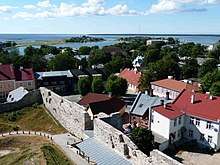Souvenir de Hapsal
Souvenir de Hapsal, Op. 2, is a suite of three pieces for piano by Pyotr Ilyich Tchaikovsky. It was his first cycle of piano pieces and it was composed in 1867.[1]
History
The Souvenir de Hapsal was written during Tchaikovsky's stay in Hapsal, then in the Russian Empire (it is now Haapsalu in Estonia). He stayed there with his brothers Modest and Anatoly Tchaikovsky as well as members of the Davydov family. He dedicated this work to Vera Davydova.[1]
The three pieces

Chromatic mediant from Tchaikovsky's Chant sans paroles, Op. 2, No. 3, mm. 43-45 
Souvenir de Hapsal consists of three pieces for the piano:[3]
- Ruines d'un chateau, E minor
- Scherzo, F major
- Chant sans paroles, F major.
The Scherzo was first performed by Nikolai Rubinstein on 27 February 1868.
The conductor Max Erdmannsdörfer orchestrated Chant sans paroles, which pleased Tchaikovsky so much that he conducted it himself.[4]
gollark: http://crates.io/crates/ggez
gollark: And a cool thing called azul - http://azul.rs.
gollark: I've seen a number of game frameworks.
gollark: There are probably SDL bindings.
gollark: It can.
References
- Souvenir de Hapsal at Tchaikovsky Research
- Benward & Saker (2003). Music: In Theory and Practice, Vol. I, p.201-204. Seventh Edition. ISBN 978-0-07-294262-0.
- PianoPedia entry
- Max Erdmannsdörfer at Tchaikovsky Research
This article is issued from Wikipedia. The text is licensed under Creative Commons - Attribution - Sharealike. Additional terms may apply for the media files.
